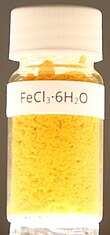| |||
| |||
| Names | |||
|---|---|---|---|
| IUPAC names
Iron(III) chloride
Iron trichloride | |||
Other names
| |||
| Identifiers | |||
| |||
3D model (JSmol)
|
|||
| ChEBI | |||
| ChemSpider | |||
| ECHA InfoCard | 100.028.846 | ||
| EC Number |
| ||
PubChem CID
|
|||
| RTECS number |
| ||
| UNII |
| ||
| UN number |
| ||
CompTox Dashboard (EPA)
|
|||
| |||
| |||
| Properties | |||
| FeCl3 | |||
| Molar mass |
| ||
| Appearance | Green-black by reflected light; purple-red by transmitted light; yellow solid as hexahydrate; brown as aqueous solution | ||
| Odor | Slight HCl | ||
| Density |
| ||
| Melting point | 307.6 °C (585.7 °F; 580.8 K) (anhydrous) 37 °C (99 °F; 310 K) (hexahydrate)[1] | ||
| Boiling point |
| ||
| 912 g/L (anhydrous or hexahydrate, 25 °C)[1] | |||
| Solubility in |
| ||
| +13,450·10−6 cm3/mol[2] | |||
| Viscosity | 12 cP (40% solution) | ||
| Hazards[4][5][Note 1] | |||
| GHS labelling: | |||
 
| |||
| Danger | |||
| H290, H302, H314 | |||
| P234, P260, P264, P270, P273, P280, P301+P312, P301+P330+P331, P303+P361+P353, P304+P340, P305+P351+P338, P310, P321, P363, P390, P405, P406, P501 | |||
| NFPA 704 (fire diamond) | |||
| Flash point | Non-flammable | ||
| NIOSH (US health exposure limits): | |||
REL (Recommended)
|
TWA 1 mg/m3[3] | ||
| Safety data sheet (SDS) | ICSC | ||
| Related compounds | |||
Other anions
|
|||
Other cations
|
|||
Related coagulants
|
|||
| Structure | |||
| Hexagonal, hR24 | |||
| R3, No. 148[7] | |||
a = 0.6065 nm, b = 0.6065 nm, c = 1.742 nm α = 90°, β = 90°, γ = 120°
| |||
Formula units (Z)
|
6 | ||
| Octahedral | |||
Except where otherwise noted, data are given for materials in their standard state (at 25 °C [77 °F], 100 kPa).
| |||
Iron(III) chloride describes the inorganic compounds with the formula FeCl3(H2O)x. Also called ferric chloride, these compounds are some of the most important and commonplace compounds of iron. They are available both in anhydrous and in hydrated forms, which are both hygroscopic. They feature iron in its +3 oxidation state. The anhydrous derivative is a Lewis acid, while all forms are mild oxidizing agents. It is used as a water cleaner and as an etchant for metals.
- ^ a b c d e f Haynes WM, ed. (2011). CRC Handbook of Chemistry and Physics (92nd ed.). Boca Raton, FL: CRC Press. p. 4.69. ISBN 1-4398-5511-0.
- ^ Haynes WM, ed. (2011). CRC Handbook of Chemistry and Physics (92nd ed.). Boca Raton, FL: CRC Press. p. 4.133. ISBN 1-4398-5511-0.
- ^ NIOSH Pocket Guide to Chemical Hazards. "#0346". National Institute for Occupational Safety and Health (NIOSH).
- ^ HSNO Chemical Classification Information Database, New Zealand Environmental Risk Management Authority, retrieved 19 Sep 2010
- ^ Various suppliers, collated by the Baylor College of Dentistry, Texas A&M University. (accessed 2010-09-19)
- ^ GHS classification – ID 831, Japanese GHS Inter-ministerial Committee, 2006, retrieved 19 Sep 2010
- ^ Hashimoto S, Forster K, Moss SC (1989). "Structure refinement of an FeCl3 crystal using a thin plate sample". J. Appl. Crystallogr. 22 (2): 173–180. Bibcode:1989JApCr..22..173H. doi:10.1107/S0021889888013913.
Cite error: There are <ref group=Note> tags on this page, but the references will not show without a {{reflist|group=Note}} template (see the help page).




